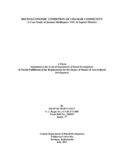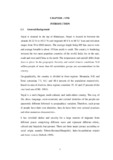Please use this identifier to cite or link to this item:
https://elibrary.tucl.edu.np/handle/123456789/834| Title: | Socio-Economic Condition of Chamar Community (A Case Study of Jamuni Madhepura Vdc in Saptari District) |
| Authors: | Yadav, Dilip Kumar |
| Keywords: | ethnographic;cultural pattern;Chamar community |
| Issue Date: | Jul-2011 |
| Publisher: | Department of Rural Development |
| Institute Name: | Central Department of Rural Development |
| Level: | Masters |
| Abstract: | The aim of the study is to give a short description of the Chamars, a socially dominated caste group of Nepal, regarding their socio-economic status. They are found mainly in Terai Region. Chamars are poorest and backward caste people in Nepal. They are born in poverty, live in poverty and die in poverty. Their life and socio-economic status is still under the smoke of cloud. So, the question is how deeply these social trends affected their daily livelihood and what change it has brought to their socio-economic status. This research attempts to focus on the various aspects of socio-economic life of the Chamar community. The general objective of the study is to identity the socio-economic condition of Chamar people and the specific objectives are as follows: a) To provide an ethnographic study of Chamars. b) To identify the problems of Chamar community. c) To explore the cultural pattern of Chamar. For this purpose, the Jamuni Madhepura VDC of the Saptari District is selected purposively. There are 96 Chamar households. The total population of those households is 528. The descriptive and the analytic methods are used in this study. Mainly primary data are used from the field study to provide the reliability and quality to the project report. The Chamars are traditionally leather workers. According to the Hindu caste hierarchy, they are Sudras and are known as Achhut (untouchable). The Chamars had migrated from India to Nepal many years back. The Chamars of Jamuni Madhepura were also migrated from India, but they first came to Siraha, Saptari and after then, they came to Saptari District. When they came to the study area, they started their traditional work i.e. leather work. Along with the passage of time, their traditional work became scarce and they gradually started to shift away from their traditional occupation. They now are depending mostly on wage labour and agriculture. The Chamars are, in general, Hindus. They worship Hindu Gods and Goddesses. The festivals of the Chamars are similar with Brahmins and Chhettris. They mainly celebrate Chhath, Dashain, Tihar, Tij, Maghe Sakranti etc. They play their traditional and modern types of band (Baja) as well. Therefore, people invite them to play their band on weddings. The Chamars are poor and exploited by the high caste group like Brahmin, Chhettri etc. Most of them are landless. Therefore, they are backward in every field. They are uneducated and backward. They have forgotten their traditional way of life. In the study area, it is hardly to see their traditional type of occupation, dress and ornaments. Although they have their own native language, they prefer to speak Nepali language. Though caste based discrimination is not so rigid as it was in the past, some discriminations still exist in the study area. They are not allowed to enter the house of Brahmins and Chhettris as well as religious places. The water of a well is not used at the same time by the higher caste people and the Chamars The conclusions found from the study area as follows: - The economic condition of the Chamars of Jamuni Madhepura is very poor. The majority of Chamars in the VDC consist of the landless, the marginalized or small farmers, who do not have enough land or other means of production for survival. - The literacy percent of the Chamars are very low and they hardly complete their schooling. The higher education attended person is nil in the Chamar community. - They practise diverse culturalal activities; they practise their religion, customes, traditions and their social values in a strong and rigid manner. - The Chamars have been subjected to economic exploitation, oppression and poverty. They are still being exploited by the so called non Dalits in many ways; opportunity, status, education etc. - Early marriage, unplanned family, economic disability, illiteracy, lack of decision making power, simplicity, landlessness, exploitation, conventional approach in agriculture are the main constraints for the socio-economic development of the Chamars of the Jamuni Madhepura VDC |
| URI: | http://elibrary.tucl.edu.np/handle/123456789/834 |
| Appears in Collections: | Rural Development |
Files in This Item:
| File | Description | Size | Format | |
|---|---|---|---|---|
| cover.pdf | 33.27 kB | Adobe PDF |  View/Open | |
| CHAPTER(1).pdf | 247.92 kB | Adobe PDF |  View/Open |
Items in DSpace are protected by copyright, with all rights reserved, unless otherwise indicated.
